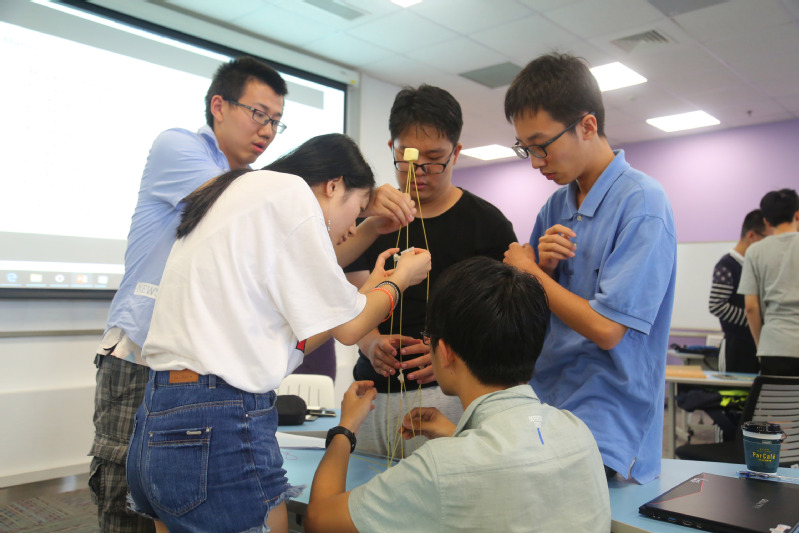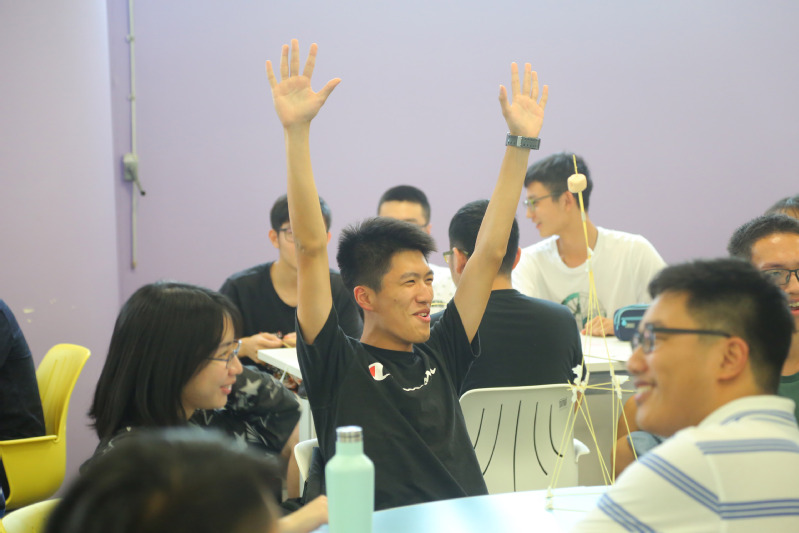Talk to any ShanghaiTech undergraduate about their most memorable classroom experience and many will mention something about building a tower out of marshmallows, spaghetti and tape. It sounds strange, but that is part of ShanghaiTech’s mandatory Design Thinking class that every freshman student takes.
The Design Thinking class was brought to ShanghaiTech after senior administration observed it at western universities like Stanford, says Chen Xue, innovation instructor at the School of Entrepreneurship and Management. After tweaking the course to fit ShanghaiTech students, who Chen says are different from the typical Design Thinking student in the US, the university has offered this course since its first year. ShanghaiTech students are younger and come from a science and engineering background, as opposed to a business background, says Chen. And in general, she says, they come to ShanghaiTech with less critical thinking skills than students in the US, so the course works with them to develop those skills. But the mix of skills and backgrounds creates a dynamic mix in the classroom she adds.
“They are from very different backgrounds and they have very different personalities. So it's a very different chemistry, a dynamic mix, in the class. We don't want to control the dynamics, we want them to grow and expand in a natural way,” she explains.
The first time when they are in the class, they are very hesitant and not as interested,” she says. But once they are in the middle of the class, they kind of open their minds. [They recognize] Students can talk whenever they want, and, It's a big class, and [there are] new people, students from other schools, all very open.” That’s when things get fun, she says.
Professor Ding Lu, Vice Dean of SEM, said that he's been inspired by the students' innovation and creative ideas. “I'd like to give special thanks to the instructors and the teaching assistants who guided the students in their exploration,” Lu says. He adds that through the Design Thinking class students have learned to apply critical thinking in detecting the problems, identifying the opportunities, and solving problems through innovative designs with imagination and technical details.
For several students, the DT class unlocks an interest in business that they didn’t know they had before. For Liu Jing Shu, a 2nd year Physics major, taking the DT class opened a door to design and marketing that she hadn’t considered before. Now she minors in Innovation and Entrepreneurship. “After I graduate, I maybe want to do something about business analytics toconnect the data and the real market,” she says.
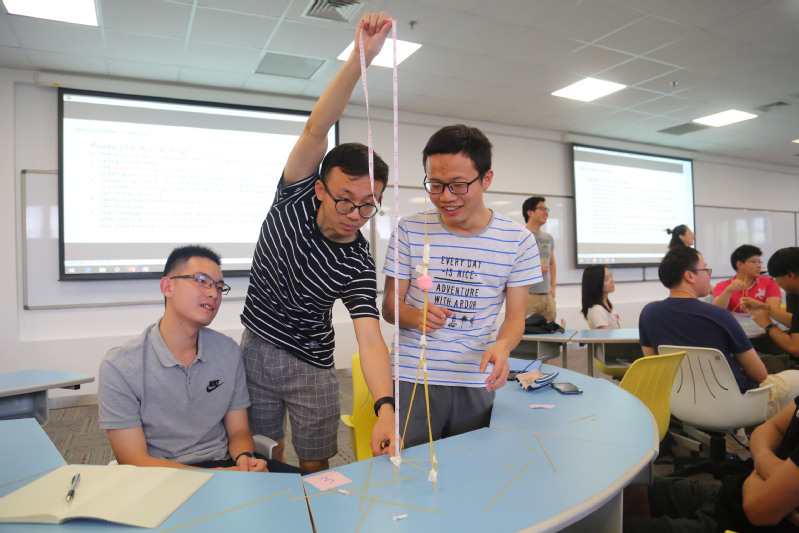
For others, it gives them an experience of connecting with society and working together to solve problems.“I like working in a team,”says rising freshman Xia Fan, a life science major.“The DT class teaches us how to think about idea, such as we will brainstorm an idea, and how to make some insights into our target user. And it teaches us how to stand in another person’s shoes.”
Long Jiefeng, a rising freshman in the School of Information Science and Technology, says he enjoyed the class so much he wishes he has the opportunity to take the class every year.“Before I went to university, I just studied every day. But now, I have a chance to know [more about] society and know different industries. And I can do more hands-on activities. It's good for my technical ability.”
Long cites the marshmallow tower class as one of the more memorable experiences in DT class. In this classroom completion, teams of students are asked to build the tallest, most structurally sound tower in 20 minutes using just raw spaghetti, marshmallows and tape. The competition is full of intense energy, as the students must quickly learn to work together, delegate tasks and recover quickly from mistakes in the process.
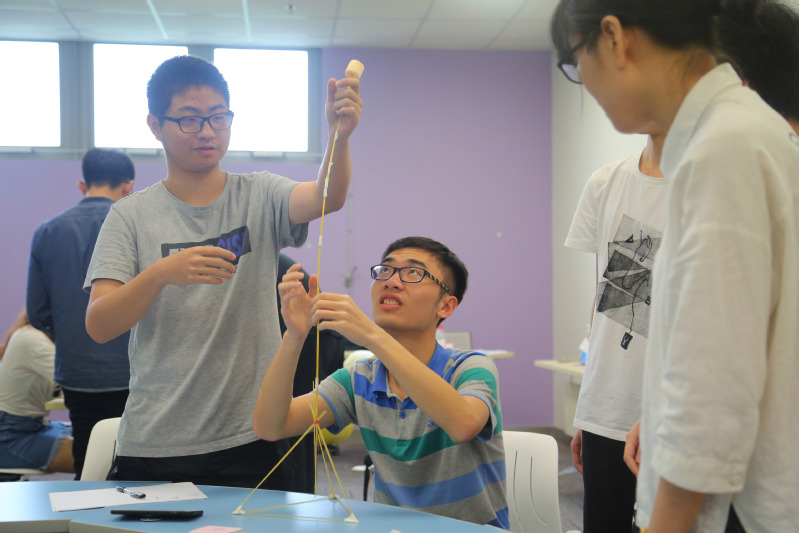
“I felt really successful,”Long says, remembering the experience, even though his tower was not the tallest and fell in the end.“I think it's already a good progress for me. It taught me a lesson. [Next time] I can do it better and firmer.”
Chen and the students agree that the chance to make mistakes and experience failure has been crucial for these students’development.“They will experience failures and mistakes in different stages of their life. We let students fall and accept affordable losses in projects many times in class. And later on, they can embrace failure in a very positive way.”
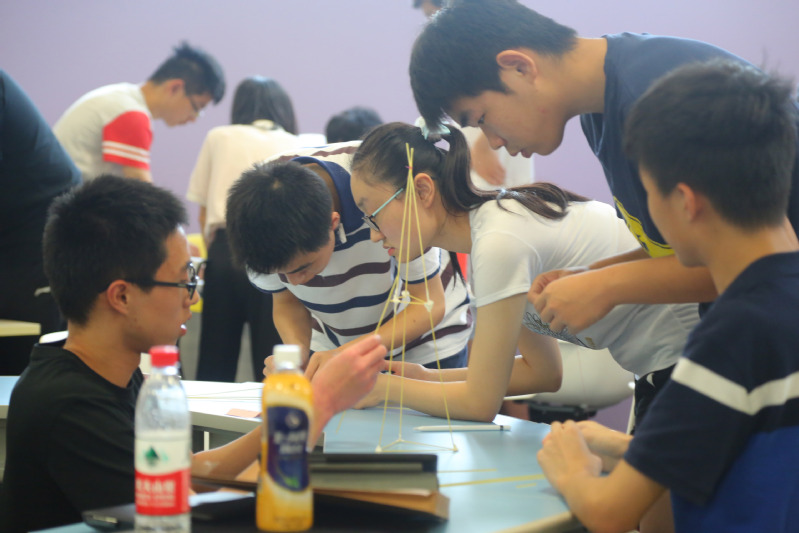
One of the major lessons that the students learn from DT class, the students say, is how to accept and use criticism. It feels bad when someone challenges your ideas, Sun Zhipeng, a third-year student says,“but it's something we should get used to, because not everyone will be nice when they give advice. But they really want to help you by challenging you. Then we can know the shortcomings of our product.”
For Zhao Zehao, a second-year Material Science major, it is simple.“I like DT most because first of all, I do not have any exams. I hate exams,”he says with a laugh.
But he gets more from the class than just avoiding exams.“Always doing science or technology research makes someone boring. We need some insights of other fields to make us more creative. [In DT] I can fight with different people with different backgrounds. It will give me a lot of insights about different fields. Also we can make friends,”he says.
Sun Zhipeng agrees.“The professor usually encourages us to have a disagreement. And sometimes, if we ask some questions to the professor, they encourage us to think on our own. They don't want to lead us to somewhere.
As for why so many students talk about DT class after they finished, he adds,“I think that it's the first experience for us [to learn in this manner], so maybe it was the one that impressed us the most.”
Sun majors in Material Science, but taking DT has expanded what he thought possible for his future career path. Now he’s minoring in Innovation and Entrepreneurship.“I want to participate in some jobs like marketing, or consulting. I think it's more fun to work with people and discuss, like teamwork. I think it's a lot of fun, rather than [only] doing experiments.”But he adds,“I don’t really want to drop my science major. I think it can help me a lot. Like if I take part in some manufacturing or high tech company, my major will help me a lot.”
Chen adds,“He's getting a lot of experience of how to pitch to new people, to managers, and he’s got several job offers. But [in the end] he rejected all of the offers and decided to do his master’s degree to further his understanding of his science major.”
The Design Thinking class has had a lasting impact on many of the students, who are utilizing the lessons they learned in it long after the class ends. Xia Fan has even taken it on herself to work on a fruit selling project outside of class. She is developing a phone app with gaming features that connect university students and faculty to farmers in western China and makes it fun for buyers to purchase a tree and then gift the fruits their tree grows.
Chen Xue says,“There’s a lot of things happening to run this business. Xia Fan has a team of project management, technical person, finance guy, operation and branding. She’s utilizing all her resources to build connections and to expand the business.”
Zhao Zehao used his summertime Social Engagement program as an opportunity to teach others what he’d learned in DT. Zhao and his classmates went from being students of DT to taking on a teaching role, as they taught middle school students Design Thinking concepts in rural Anhui Province.
“Some students don’t even know about Baidu maps. We spent a long time teaching them what is design thinking,”he remembers. When he and his classmates return to ShanghaiTech, local students in Anhui gave positive feedback.“They said [our class will] somehow change their life. [We helped them] to get in touch with a lot of new things for them.”
“That’s beyond my expectation,”says Chen.“That's very important. I never imagined our students would teach others [what they learned in DT class].”
Chen says that the course is also developing and changing with each class as they learn from the students.“We get to know the students and we test different contents in class. We admit affordable losses and we also make mistakes. And during some sections, when student are not buying it, we will adjust and change teaching materials. So we are doing our own iteration every semester.
For example, she says,“if this year’s students are coming in with better English skills than previous classes.we add more English-language presentations. If [we see the] students are more research-focused, we will make our topics more focused on science people. So we change our topics, we change our sections, and we change our instructors every semester to bring new ideas and new inspiration.”
But even as things grow and develop, one thing is for sure. The Design Thinking class has become a ShanghaiTech tradition that is having a strong impact on the futures of each student that takes it. And it is helping ShanghaiTech foster the cross-disciplinary, innovative research that is at the core of the school’s mission.
